Infrared heating with various equipment
Along with traditional home heating systems, the most innovative options are becoming increasingly common. Infrared floor heating combined with wall or ceiling heat radiation is particularly popular. Before you learn more about the equipment used, you need to know what electromagnetic radiation is, as well as its pros and cons.
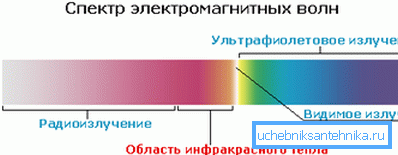
Positive and negative sides
In the modern world, infrared heating systems are gradually gaining popularity. They are based on electromagnetic radiation, which is located in the spectral region between the microwaves and the red segment of visible light. Below it is proposed to consider the advantages of this method of generating heat.
The most important advantages
- Since the price of equipment is relatively low, it is quite possible to create low-cost heating systems.
- During operation, oxygen is not burned or air is dried excessively, so there is no need for strong ventilation.
- The room begins to be heated immediately, because there is no intermediate coolant in the system.
- The low power consumption makes it possible to operate infrared heaters quite economically.
- The service life of equipment that produces thermal radiation, may be more than 20-25 years.
- If necessary, the installation of basic fixtures can be done by hand, which will significantly save.
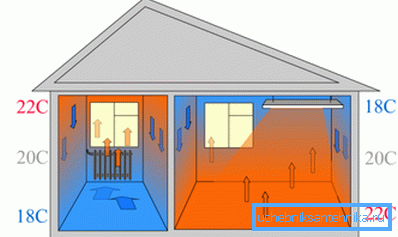
Negative points
- The system is dependent on electricity, which means that it is not heated when it is turned off.
- Too intense radiation can cause some harm to the human body.
- On the surfaces during the operation of this type of heating can accumulate static electricity, attracting dust.
Note! Many people are wondering whether infrared heating is actually harmful. However, as shown by medical research, it all depends on the intensity and wavelength.
Used equipment
It is possible to create heating of the dwelling with the help of thermal radiation in different ways, since the devices used can differ significantly. It is worth considering the most popular options that can be combined with each other or used separately.
Film mats
Such products are designs consisting of two layers of polymers and heating elements with unique characteristics. The carbon source is used as a heat source. Atoms are arranged in a hexagonal lattice, the size of which is several nanometers, so the products are capable of producing radiation in the infrared spectrum.
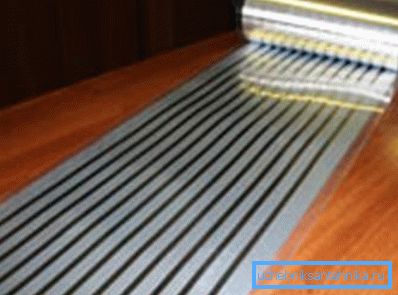
To carry out the installation of infrared heating is quite possible without the involvement of specialists. You only need to familiarize yourself with the basics of styling elements
The instructions below should help with the work:
- At the first stage, the base is leveled.. If the horizontal surface has a deviation of at least 3 mm, then resort to using a self-leveling floor.
- In the side surface a channel is made from the floor to the place of installation of the thermostat for heating. After completion of this operation, the resulting garbage is completely removed.
- Reflective insulation is laid on the lower plane. The thickness of the layer should not be less than 5 mm. The joints are taped with masking tape.
- Infrared mats on top. They are laid towards the thermostat to reduce the length of the wire. From side surfaces should retreat 100-200 mm.
- Open areas are isolated where there is a copper cut. For these purposes, most often used bitumen materials. However, the segments to which the wires will be connected must be left open.
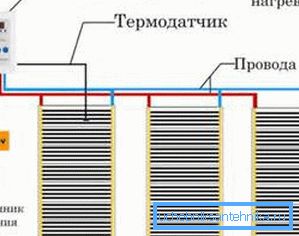
- Clips from metal join the main conductors. One side of the fastener is placed between the copper strip and the film. Clamping from above is prohibited.
- Mounted parallel to the clips. The ends are trimmed with a special tool, and then twisted and inserted into the hole of the fastener.
- At the finish line, wires are laid, the thermostat is installed and other equipment works.. After that, system performance is tested using a sensor.
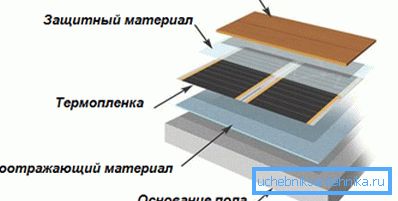
Attention! To make an approximate calculation of infrared heating, you need to use the following formula: W = S * K, where W is the power in watts, S is the area of the room, and K is the required power per square meter.
Radiant Panels
Another option is to use committed other devices. In this case, installed water infrared heating panels, which are located on the ceilings or walls. Products up to 70 percent of heat emit through radiation.
If infrared water heating will be installed independently, then you should familiarize yourself with the basic rules.
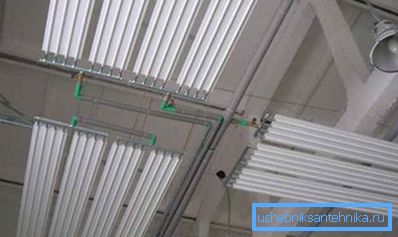
- Do not place panels too close to objects that quickly ignite.
- It is not allowed to turn on the products until they are fixed on the wall or ceiling.
- In the process of installation on the device should not be a strong mechanical impact.
- For bathrooms, saunas, baths and other rooms with high humidity should use special products.
- When installing the cable must be laid on the base, made of non-combustible materials.
- It is necessary to exclude cases in which fasteners will pass directly through the heating device.
- Infrared heaters of this type should be installed with a gap of 30-60 mm from the ceiling or side plane.
- It is allowed to mount the panels on fixtures of the lighting system, pendulum pendants and horizontal cables.
- Products should be placed in 170 cm from the floor, while in front of them should not be beds, sofas and other furniture for rest.
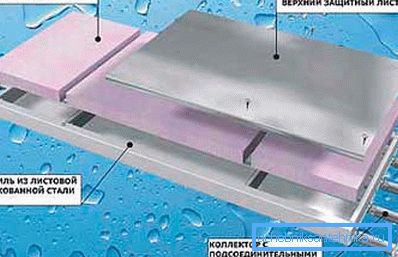
Note! Although heating with infrared heaters in the form of panels can be carried out at the top and bottom, it is best to install the elements on the ceiling. Side placement reduces the efficiency by about three times.
Finally
Film and water infrared heating can be successfully combined if necessary. First you need to put the mats under the flooring, and then install special panels on the ceiling (see also the article Infrared heating systems: types and advantages).
For more information, it is recommended to view a special video.